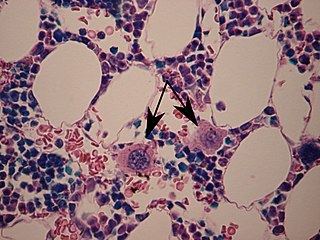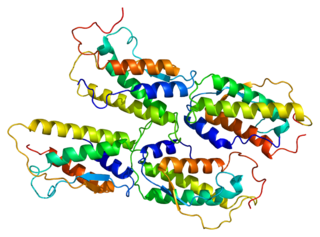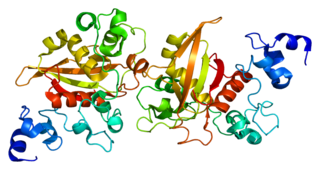Related Research Articles

Haematopoiesis is the formation of blood cellular components. All cellular blood components are derived from haematopoietic stem cells. In a healthy adult human, roughly ten billion to a hundred billion new blood cells are produced per day, in order to maintain steady state levels in the peripheral circulation.

A megakaryocyte is a large bone marrow cell with a lobated nucleus that produces blood platelets (thrombocytes), which are necessary for normal clotting. In humans, megakaryocytes usually account for 1 out of 10,000 bone marrow cells, but can increase in number nearly 10-fold during the course of certain diseases. Owing to variations in combining forms and spelling, synonyms include megalokaryocyte and megacaryocyte.

Thrombopoietin (THPO) also known as megakaryocyte growth and development factor (MGDF) is a protein that in humans is encoded by the THPO gene.
Primary myelofibrosis (PMF) is a rare bone marrow blood cancer. It is classified by the World Health Organization (WHO) as a type of myeloproliferative neoplasm, a group of cancers in which there is activation and growth of mutated cells in the bone marrow. This is most often associated with a somatic mutation in the JAK2, CALR, or MPL genes. In PMF, the bony aspects of bone marrow are remodeled in a process called osteosclerosis; in addition, fibroblast secrete collagen and reticulin proteins that are collectively referred to as (fibrosis). These two pathological processes compromise the normal function of bone marrow resulting in decreased production of blood cells such as erythrocytes, granulocytes and megakaryocytes, the latter cells responsible for the production of platelets.

Selectin P ligand, also known as SELPLG or CD162, is a human gene.

Interleukin 3 (IL-3) is a protein that in humans is encoded by the IL3 gene localized on chromosome 5q31.1. Sometimes also called colony-stimulating factor, multi-CSF, mast cell growth factor, MULTI-CSF, MCGF; MGC79398, MGC79399: the protein contains 152 amino acids and its molecular weight is 17 kDa. IL-3 is produced as a monomer by activated T cells, monocytes/macrophages and stroma cells. The major function of IL-3 cytokine is to regulate the concentrations of various blood-cell types. It induces proliferation and differentiation in both early pluripotent stem cells and committed progenitors. It also has many more specific effects like the regeneration of platelets and potentially aids in early antibody isotype switching.

P-selectin is a type-1 transmembrane protein that in humans is encoded by the SELP gene.

The granulocyte colony-stimulating factor receptor (G-CSF-R) also known as CD114 is a protein that in humans is encoded by the CSF3R gene. G-CSF-R is a cell-surface receptor for the granulocyte colony-stimulating factor (G-CSF). The G-CSF receptors belong to a family of cytokine receptors known as the hematopoietin receptor family. The granulocyte colony-stimulating factor receptor is present on precursor cells in the bone marrow, and, in response to stimulation by G-CSF, initiates cell proliferation and differentiation into mature neutrophilic granulocytes and macrophages.

Chemokine ligand 7 (CXCL7) is a human gene.

Stem cell factor is a cytokine that binds to the c-KIT receptor (CD117). SCF can exist both as a transmembrane protein and a soluble protein. This cytokine plays an important role in hematopoiesis, spermatogenesis, and melanogenesis.

Neurogenic locus notch homolog 4(Notch 4) is a protein that in humans is encoded by the NOTCH4 gene located on chromosome 6.

Neurogenic locus notch homolog protein 2 is a protein that in humans is encoded by the NOTCH2 gene.

The thrombopoietin receptor also known as the myeloproliferative leukemia protein or CD110 is a protein that in humans is encoded by the MPL oncogene.

CD177 antigen is a protein that in humans is encoded by the CD177 gene.

Rho guanine nucleotide exchange factor 2 is a protein that in humans is encoded by the ARHGEF2 gene.

Tyrosine-protein kinase receptor TYRO3 is an enzyme that in humans is encoded by the TYRO3 gene.

Sialic acid-binding Ig-like lectin 5 is a protein that in humans is encoded by the SIGLEC5 gene. SIGLEC5 has also been designated CD170.

Mitogen-activated protein kinase scaffold protein 1 is a scaffold protein that in humans is encoded by the MAPKSP1 gene.

Homeobox protein Meis2 is a protein that in humans is encoded by the MEIS2 gene.

Pre-B-cell leukemia transcription factor 3 is a protein that in humans is encoded by the PBX3 gene.
References
- ↑ Kratz-Albers K, Scheding S, Möhle R, Bühring H, Baum C, Mc Kearn J, Büchner T, Kanz L, Brugger W (2000). "Effective ex vivo generation of megakaryocytic cells from mobilized peripheral blood CD34(+) cells with stem cell factor and promegapoietin". Exp Hematol. 28 (3): 335–46. doi: 10.1016/S0301-472X(99)00152-6 . PMID 10720698.
- ↑ Definition of promegapoietin – NCI Dictionary of Cancer Terms
- ↑ Doshi P, Giri J, Abegg A, Favara J, Huynh M, Kahn L, Minnerly J, Pegg L, Villani-Price D, Siegel N, Staten N, Thomas J, McKearn J, Smith W (2001). "Promegapoietin, a family of chimeric growth factors, supports megakaryocyte development through activation of IL-3 and c-Mpl ligand signaling pathways". Exp Hematol. 29 (10): 1177–84. doi: 10.1016/S0301-472X(01)00694-4 . PMID 11602319.